The recent study trip to the Yaeyama Islands provided us with a comprehensive exploration of the implementation of the Sustainable Development Goals (SDGs), with a particular focus on Ishigaki Island and Taketomi Island. Through immersive experiences and interactions with local people, we observed diverse efforts being made in the region to achieve the different SDGs.
Our second day on this captivating island began with an exploration of the Kabira Maetake Farm, affectionately known as the Pineapple Farm, which was established in 1970 by the grandfather of the current farmer. Ishigaki Island has the perfect red clay soil, so they can grow delicious pineapples. Surrounded by swaying palms and vibrant flora, we were greeted by the sweet aroma of ripe pineapples and mangoes, inviting us to delve into their world of flavors.

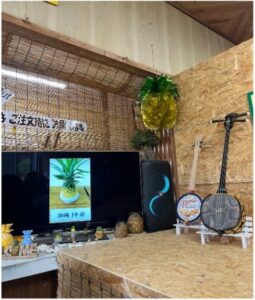
Our excursion at the Pineapple Farm commenced with an informative lecture, followed by visits to the plantations and greenhouses, culminating in the enjoyment of mango and pineapple juicy smoothies. Stepping inside the lush greenhouses and expansive plantation, we were captivated by the sight of row upon row of pineapple trees, each promising juicy sweetness.
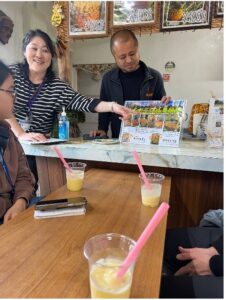
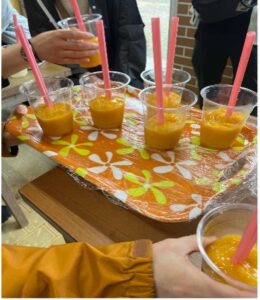
The history of pineapples on Ishigaki Island is deeply intertwined with the island’s rich past. Initially brought to Ishigaki by migrant settlers from Taiwan, pineapples found a fertile environment in the island’s rich soils and abundant sunlight. This historical narrative continues at Kabira Maetake Farm, where eight distinct pineapple cultivars are available, each offering a unique charm and flavor character.
We began by learning about the Jewel Pine, a juicy delight boasting the perfect balance of sweetness and acidity, typically harvested between June and July. The Jwari Pineapple, known for its rich juice content and jewel-like pulp, provides a refreshing treat during the summer months. Its name derives from its abundance of juice, offering a perfect way to stay hydrated in the tropical heat.
Next, we were introduced to the Peach Pine, a delicate fruit with a fragrant aroma reminiscent of summer peaches, usually harvested from April to July. Characterized by its soft, whitish flesh, this variety is carefully nurtured over nearly three years. They are smaller than regular pine trees, but they have a concentrated aroma and sweetness. The pulp is soft, and people can eat the core.
As our exploration continued, we encountered the Pokot Pine, a snackable delight bursting with intense sweetness, harvested between April and June. Named for its ability to be easily torn into pieces, this variety offers a less sour taste with a stronger aroma, appealing to those who prefer sweeter pineapples.
We then learned about the Julio Star Pine, a rare variety known for its exceptional taste, developed over 20 years to achieve a perfect balance of sweetness and acidity. Despite its limited production, its high sugar and juice content, coupled with a pleasant aroma, make it a sought-after delicacy. This sort is a cross between the popular standard pine variety “Hawaiian Pine”, and the variety “Cream Pine”, which has a reputation for its taste. This pineapple is perfect for the tropical island of Okinawa, where people can enjoy its juiciness and refreshing taste. It is a rare pine tree whose production is still small, and few people have ever eaten it, even on Ishigaki Island.
Then, there is the Pearl Pine, a golden treasure renowned for its unique taste and chewy sweetness. The farmer also mentioned the Sandolce, a pineapple like no other, with low acidity and outstanding sweetness. “San Dulce” is a trademark of a pineapple called “Okino P17” that is high in sugar content, disease-resistant, and typhoon-resistant, and was bred by Okinawa Prefecture by breeding “Yugafu” and “Summer Gold” over 15 years. The fruit, which is harvested not only in summer but also in autumn, is sweeter than other varieties.
Next, we learnt about the majestic Gold Barrel, a pineapple fit for royalty with its juicy sweetness and soft texture. Gold Barrel is about twice the size of a regular pine tree, weighing 1.4 kg to 2.8 kg, has golden flesh, and has a barrel-shaped fruit. It has a high sugar content and is characterized by a refreshing and elegant sweetness. It is characterized by the fact that it does not have the sourness and harshness typical of pine. The inside is so soft that you can eat it all the way to the core, and the juice will overflow when you put it in your mouth.
Finally, we were introduced “white coco” pineapple that was registered in December, 2021. It is characterized by a sweet coconut-like scent and is soft and large, with a sugar content of 16%.
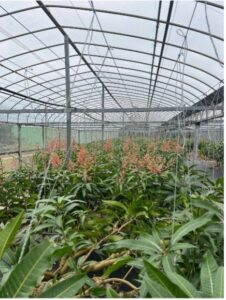
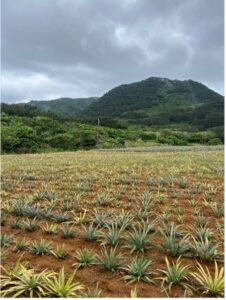
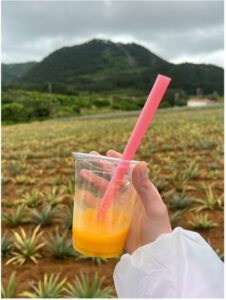
Pineapples have the characteristic that their sugar content does not increase after they are harvested, so they are left to ripen on the tree and are harvested at the time when their sweetness is at its peak. Usually, it takes two years to harvest, and in the end of July all eight kinds of pineapple can be harvested. When pineapples ripen, thorns appear on them. A high-quality and ripe pineapple can be identified by its special sound. If the sound does not match, it means there is still a lot of water in the pineapple, and it is not fully ripe.
Pineapple sizes vary by type, as mentioned above. The smallest pineapple weighs 800 grams, and the largest weighs 2-5 kilograms. By the way, pineapples are considered an expensive treat on the islands and their price usually varies from 3,000 to 7,000 yen.
But what truly sets these pineapples apart is not just their variety, but the careful attention with which they are cultivated. The farmers here take great pride in properly tending to each plant, preferring a manual method over chemicals. As a result, every pineapple that ends up on the plate is a monument to their skill and commitment as the farmers here pour their hearts and souls into tending to each plant.
Although we may not have tasted these pineapples firsthand, the farmer’s stories painted a vivid picture of Ishigaki’s pineapple paradise. Moreover, Kabira Maetake Farm offers more than just pineapples. Surrounded by rustling leaves and swaying palms, this area also offers an extensive selection of other tropical fruits. There are plenty of delights to tempt the tastes, ranging from the spicy bitterness of Shikuwasa to the deep sweetness of Kabira Mangoes.
As we said goodbye to the Kabira Maetake Farm, our hearts were full and our bellies even fuller, filled with the warmth of tropical sunshine and the sweetness of juicy smoothies and natural fruits. Afterwards, we could not help but reflect on the magic of Ishigaki Island, where every pineapple tells a story and every mango whispers of paradise found.



